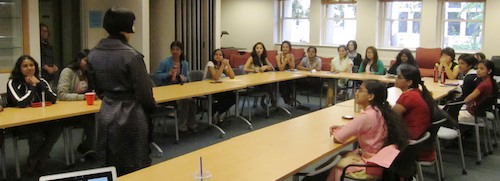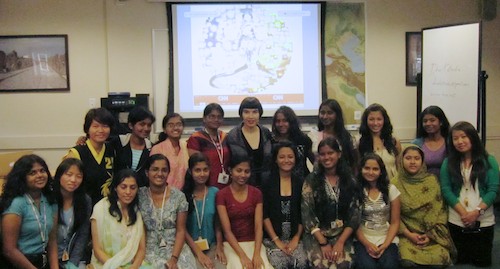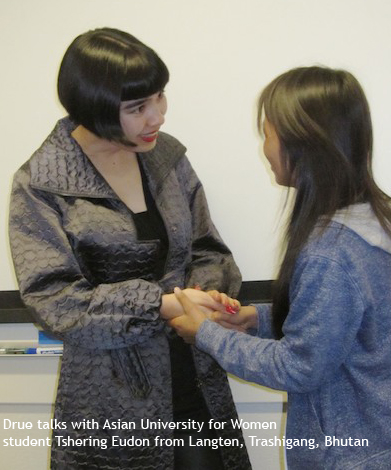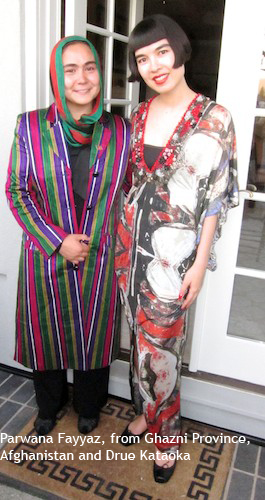Art Presentation for the Asian University for Women

This past Friday I gave a presentation on art as a cultural bridge to a group of young women from Afghanistan, Bangladesh, Bhutan, Cambodia, China, India, Myanmar, Nepal, Pakistan, Palestine, Sri Lanka, and Vietnam. I was speaking to students visiting Stanford University from the Asian University for Women located in Chittagong, Bangladesh. For many of the students, it was their first overseas trip. They were attending a four-week program at Stanford led by Richard Saller, Dean of Stanford’s School of Humanities and Sciences.

This special group of young women have been selected among the 350 undergraduates of the Asian University for Women, a young and exciting organization founded in 2008. The Asian University for Women, while modeled after American liberal arts colleges, has a British-style leadership structure common in South Asia with an honorary Chancellor who presides at ceremonial events and a Vice Chancellor who has the responsibility of running the University. Mrs. Cherie Blair, a leading UK human rights lawyer and wife of former British Prime Minister Tony Blair, was appointed the first Chancellor in January 2011. Earlier in the week I attended a gathering at the home of Prabhu & Poonam Goel with Dr. Condoleezza Rice, AUW Patron, Dr. Mary Sansalone, AUW Vice Chancellor, Janet Montag from the AUW Support Foundation Board and AUW International Advisor Sara Abbasi (Chairman Developments in Literacy). Former Secretary of State Dr. Rice’s comments on art were very insightful and moving.

In Friday’s presentation at Stanford, I showed slides of some of my recent works of art such as Footsteps in the Snow, which I had presented earlier this year at the World Economic Forum in Davos. Footsteps in the Snow is a painting of the Alpine landscape around Davos. In the center of the painting there is a footbridge/path that leads into the summits on the horizon. But while the mountains are painted in ink, the path is made of mirrors and the footsteps are made out of light arranged to shine from behind the layers of silk scroll and mirror. The students liked the idea of seeing themselves reflected in the path when standing in front of the work. In fact, each of them is on a distinct and bold journey. And the theme of bridges resonated with them, as they are bridges between their culture/country and the world. Few of the women in their hometowns have had the opportunities the AUW students now have, and the chance to cultivate a voice that will be heard.
For example, I received a touching email from AUW Asian Studies major Parwana Fayyaz, whom I met earlier in the week. She is originally from Ghazni Province– as she points out, known as “the home of the Taliban” in Afghanistan and beyond. She had talked about the terrible memories of war in Afghanistan at the gathering at the Goels’. There she she had also recited from her autobiographical essay/poem, “My Afghanistan is a broken ship. I want the world to know that, although we are sometimes invisible, women too are traveling in this broken ship, and we are part of this land.”

The AUW students very much believe in the power of art to build important cultural bridges. I liked that they re-enacted a drama project featuring Sri Lankan students– both Sinhalese and Tamil. They used a dramatic format to reflect on the 30-year bloody conflict that ravaged the landscape and economy of their home country. But interestingly, Sinhalese “played” the role of the Tamils and Tamil students acted the Sinhalese. One student said “While every one of us has a story linked to the war, we were blind to see that a change was possible…prior to attending AUW.” The AUW experience clearly takes the importance of diversity to a new level.
After presenting the slides of my artworks, I ended my presentation by talking about applying a very traditional Japanese art form into modern contexts. Some of my works refer to traditional subject matter, but incorporate new techniques. One student said that she loved this idea of looking forward and back at the same time. We ended the day with photo-taking and hugs, and the students surprised me by asking when I would be coming to Bangladesh. I don’t know the answer to that, but someday perhaps I will.



Ms. Drue, meeting women leaders like you was one of the highlights of our stanford trip. The way you incorporate modernity and traditionality in your artforms and your creative ideas are simply amazing.We really hope that you will visit us in our university.:)